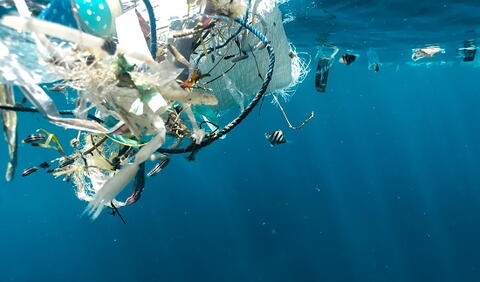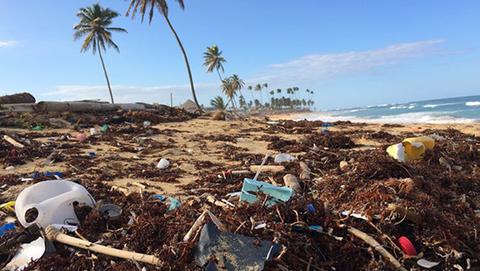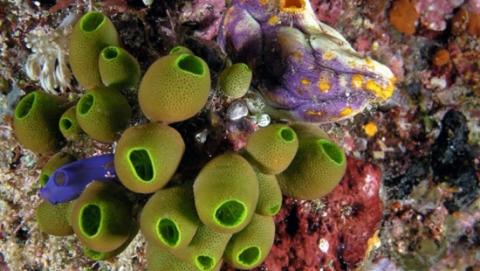
Microfibers of the Mediterranean
A consortium of bacteria form on the microfibers of the Mediterranean Sea, becoming "floating homes for bacteria". Maria Luiza Pedrotti, a CNRS researcher at the Villefranche-sur-Mer oceanography laboratory has reported the presence of a pathogenic bacterium on the tiny textile fibers found in the deep blue sea.
The Mediterranean is the most polluted sea in the world by microplastics. How long have you been studying this phenomenon?
Maria Luiza Pedrotti: I became interested in plastic pollution in the Mediterranean when in 2014 I participated in the Tara Mediterranean expedition of the Tara Ocean Foundation. Initially, my research at the Villefranche Oceanography Laboratory (LOV) focused mainly on zooplankton. But, during this six-month expedition, I was struck by the quantity of plastics that we brought up in our nets. Plastics often mixed with zooplankton. I had the idea that this "harvest" was rather punctual, but it turned out that it was not. I then realized that plastic pollution is indeed omnipresent in the entire Mediterranean basin. Following this expedition, I set up a research group to study microplastics.

Where do these microplastics come from?
M-LP: Part of the pollution comes from so-called secondary plastics, which are produced by the fragmentation of objects, such as a bottle thrown into the sea, which will fragment little by little until it becomes our famous microplastics, which are about the size of a confetti (less than 5 mm). They are the most abundant in the seas and oceans, especially in the Mediterranean. Imagine: when the fragmentation of a plastic starts, it will be continuous over time in the sense that the plastic can take 400 years to degrade.
There is also pollution from primary plastics, directly released into the environment, such as textile fibers. Every time a piece of clothing is washed in a washing machine, thousands of fibers are released. While sewage treatment plants are able to filter out some of these fibers, they cannot filter out all of them. The fibers are therefore found in streams, rivers, sea ... This is especially notable on the southern shore of the Mediterranean where many countries do not have treatment plants. In that case, everything is then dumped into the water...
Several decades ago, this problem was not as significant, because we used the washing machine less and the majority of textiles were made of cotton. Today, the textile industry uses millions of tons of plastic for the production of clothing and even if natural fibers degrade faster, they still pollute the environment. In the Mediterranean, about half of the microfibers harvested are of synthetic origin.
These fibers come mainly from clothing, but not only. They are also found in fishing nets made of nylon that wear out naturally in the sea or that are sometimes abandoned by fishermen. Knowing that nylon takes 600 years to degrade, we can say that these ghost nets continue to fish and harm marine organisms and mammals during all this time...
By analyzing these microfibers, you realized that they were breeding grounds for bacteria...
M-LP: Indeed! To discover the bacteria living on these microfibers, we used advanced microscopy techniques and DNA sequencing. We discovered that on average more than 2,600 cells live on each microfiber. These cells belong to 195 species of bacteria, including Vibrio parahaemolyticus, a potentially pathogenic bacterium that causes food poisoning. As with plastics, a bacteria-rich ecosystem forms on these textile microfibers.
What are the risks of this bacteria?
M-LP: First of all, there are health risks. The presence of the bacterium can pose a threat to swimming and seafood consumption. Other studies have found that it has already decimated hundreds of oysters in the oyster park of the Etang de Thau, which is separated from the Mediterranean by a thin lagoon.
The spread of these Vibrio bacteria are linked to a double factor: the increase of plastic pollution, especially in summer with the increase of the local population by tourists, as well as the role of climate change. At the time we found this Vibrio, the water temperature in the area at that time averaged around 26 degrees, while this year it has reached 29 degrees.
If there are risks for humans, we imagine that there are also risks for marine fauna. What are the consequences of ingesting microfibers in fish?
M-LP: Marine organisms are attracted by the food-like odor of microfibers and consume them. Because of their persistence, microfibers accumulate in their organisms. Scientists have shown that tiny pieces of plastic, called nanoplastics, enter the fish’s brain.
Even though it is very complex to separate microfibers from plastics in the digestive system of fish, some studies have shown that in the most polluted areas of the planet, the reproduction rate of fish decreases.
Are there any solutions?
M-LP: Some initiatives, which I welcome, are trying to find solutions to clean the sea, but we have to be realistic, it is not possible! You know, I also had the opportunity to participate in the Tara Pacific expedition during which we crossed the infamous ocean of plastic or 7th continent.
I expected to see big plastic waste floating there, but it is mostly fine particles, tiny confetti that form this soup of garbage. It is impossible to clean all this, especially since these micro-particles are also intermingled with living things like plankton.
I think we need to stop this pollution upstream by further regulating the ban on single-use plastics. We also need to take responsibility: avoid single-use plastic, buy less clothes, use our clothes better, rethink the way we wash clothes... By filling a machine to the brim, fewer fibers come off during the wash. Some manufacturers are even thinking of integrating special filters in new machines.
Even if we can't clean the Mediterranean, solutions exist to reduce our impact on this pollution.


